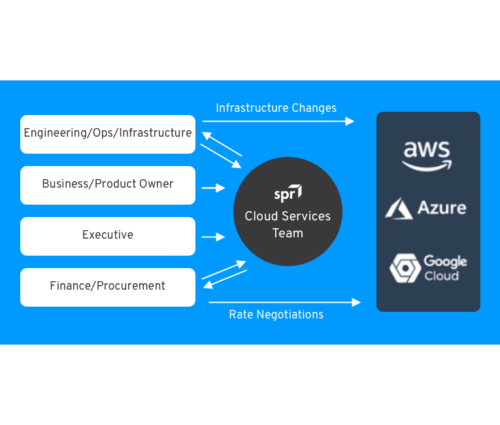Cloud Cost Optimization: A Quick Guide to Saving Money
Given the current economic environment, major transformations are taking place in the workplace. Important strategic initiatives have been put on hold as organizations are harder pressed than ever to maintain operations, and control budgets and forecasts. They must also plan for the future—all of this in an economy that has never felt more unpredictable. Your goal is to ensure you are making the most of your cloud environment and budgets, so your organization maintains good financial health. You must stand ready to quickly pivot all facets of your organization and, most importantly, to secure the resources needed to move initiatives forward.
One way organizations can achieve greater operational cost efficiencies is through cloud cost optimization. It starts with managing and maintaining a cloud governance strategy with the overall effect of controlling monthly spend and providing the infrastructure that your environment requires. All this happens while effectively monitoring your cloud subscriptions and limiting IT spend in order to optimize the overall usage of your cloud technologies and maximize your return on investment.
It is important to note that cloud cost optimization is not just a technology implementation. There is no special tool that will magically solve issues and lead to cost savings.
Instead of a tool or technology, a set of processes and policies help to align different business units to cloud and infrastructure requirements and provide you with the data needed to appropriately negotiate with your vendors and partners. In its purest form, Cloud Cost Optimization involves a dedicated team that offers a holistic approach (SPR's team offers an experienced perspective and ability to operate cross-functionally to manage the cloud strategy, governance). Using a commonly defined framework, the rest of your organization can utilize cloud resources more efficiently.

Our Cloud Services team engages with clients in one of two ways:
- We act as accelerators.
We dynamically set up what you need and transition it to your organization. For example, we partnered with a global financial services organization to provide expert insight on how to optimize their cloud costs. After conducting a thorough review of their entire cloud-based portfolio, we helped to implement systematic recommendations that ultimately reduced monthly cloud spend by 50 percent. - We act as an extension of your team.
We help you to best operate your cloud practice, and in doin so, we will work to learn more about how your organization operates, understand the existing strengths and weaknesses, and use the knowledge of our expert architects and engineers to foster the beginnings of a long-term partnership. One of our clients, a medical manufacturing company, recently engaged SPR to assist with the management of projects in development, while accelerating operations and reducing cost. We helped them to realize and create efficiencies that streamline the project processes with a focus on achieving all of that at the least cost. As a result, the company has opted to turn cloud subscription management over to SPR long term so that internal talent can be directed to higher value efforts.
Controlling Cloud Costs: Factors and Strategies
A consulting partner, such as SPR, can help your organization define success criteria for your specific cloud environment needs, and then help you to manipulate these factors in your favor in the most efficient ways possible. Every organization and environment has different needs, so it is essential to look at actual consumption of resources (i.e. what the end user is really using), not guessing or using projections that show "typical" or "estimated" usage.
You will want to measure cloud performance and operational spend against a variety of key performance indicators (KPIs). Our SPR cloud team would help you identify, specific to your organization's needs. Then, you compare the KPIs against actual usage data and use that to map success to those goals that are defined at the outset of an engagement with SPR. While each organization is unique, some examples of KPIs include: service/system availability, reliability, response time, security, throughput, capacity, scalability, latency, service and helpdesk (response time), and cost per customer.
Pricing Factors
Region: Where you choose to build out your cloud resources will make a difference in pricing; for instance, the East U.S. vs. the West U.S. regions.
Resource Types: Instances provide a balance of compute, storage, and networking, that can be used for a variety of workloads.
- Instance Size: Scalability of resources, targeted to the requirements of your workload. Choosing improperly-sized resources can have negative effects on operational spend, if your organization in purchasing more than they are using, or performance, if your organization is not effectively scaling resources to meet changes in the flow of demand.
- Reserved Instances: A properly constructed Cloud Governance plan includes forecasting estimated usage for each organizational application, platform, and cost center, paying upfront for "reserved, computer instances" and realizing a cost savings of up to 70 percent in some instances.
- Spot Instances: Just as it sounds, Spot Instances are perfect for intermittent usage. According to Amazon, using spot instances can generate costs saving of up to 90 percent.
Software Licensing: Does your organization already have an investment in software licenses that are being used in your own Data Center? If so, that does not have to be a blocker in your plans for cloud migration. Many software developers offer convertible licensing terms, where you can assign licenses to cloud-deployed resources and eliminate the license spending component from the resource.
Compute Platform: Taking the time to understand your applications, the needs of your business and the expectations of your customers is part of how we use our relationship with your organization to help design platforms that take the biggest advantages of the cloud resources available. Decoupling applications and creating converting monolithic platforms into a series of microservices are examples of how your organization's computer needs can be extracted from an application to take advantage of serverless platforms, containers, and other cloud-native compute resources.
Waste: Governance includes the ability to report on, track and monitor resources that have been deployed within your organization. Sprawl can contribute to orphaned resources and lead to paying for something you may not need. Creating a detailed organizational structure, with proper cost control and monitoring, will give your organization insight into their operational spending, and can help to define lifecycle policies to eliminate wasteful spending.
Consumption Factors
Application Design: How are your organization’s applications built? In order to make the best informed decisions, with the intent of ultimately delivering a product that meets your end user’s requirements, not the latest—and possibly unnecessary—technologist’s dream, while keeping in mind supportability and long term viability of a product. We cannot fix what we do not know, nor can we understand when we do not ask. Having the expertise to know, “when to ask more” is a benefit to working with a team of highly qualified architects and engineers. Translating those findings into requirements to define success from the outset, is the true mark of an organization who wants to build a long-term partnership that benefits everyone.
Resource Sharing: Your organization must make smart decisions about risk and data security, or else they will be left “to the wolves,” as the saying goes. With the cloud comes the power of virtually unlimited scalability. That scalability, however, is built on top of a shared resource platform. Taking control of your data by designing your cloud with a “security first” mindset is how modern organizations work to continually improve security within their environment.
Cloud Architecture: Every organization’s journey to the cloud is unique, and must be appropriately architected, engineered and executed. Some resources will migrate easily and natively to the cloud, while others may require a “lift and shift” approach.
Cloud Cost Management Strategies
Right-Sizing: Ensure that the cloud resources chosen are the right fit for your organization’s needs, and that regional considerations of performance and availability are accounted for.
Automatic Scaling: Allows organizations to scale resources up and out, when needed, and scale down when not, rather than planning for maximum utilization at all times (which is often needlessly expensive). The use of application decoupling practices can organizations realize where flexible performance can be beneficial, and where processes need to be coupled for performance, security, or regulatory purposes.
Power Scheduling: Not all resources need to be used 24/7. Scheduling non-essential instances to shut down overnight or on weekends is more cost effective than keeping them running constantly. An example of an efficient deployment of Spot Instances can be realized if you can identify an off-peak time for your compute needs.
Removing Unused Instances: If your organization is not using an resource, there is no need to keep it running and continue paying for it. Removing unused instances is also important for security, where unused, and often unmanaged, resources can create vulnerabilities.
Discount Instances: Since discount instances usually do not guarantee availability, they’re not appropriate for business-critical workloads that must run constantly—but for occasional use, they can result in a significant cost savings.
Organizational Strategies: In addition to the IT strategies outlined above, creating operational IT budgets, and setting cost-containment policies around cloud usage is key to cloud cost management.
Putting it into Practice
A current client of ours is a prestigious financial firm that engaged our team to help reduce the workload on their core application. While achieving cost savings was their ultimate end goal, we did not approach the project from a savings standpoint. Rather, we took a service delivery approach. We focused on information gathering to realize that scaling down would better meet the real need of the application. We also helped to identify resources that were being underused and scaled them back. Any resources that were not in use were considered waste and removed from the environment—liken it to a “spring cleaning” of their cloud environment.
The results were tremendous. While we did not attack the project from a cost optimization aspect, the gains were financial (but we knew that this is what the client asked for). Small inefficiencies in a cloud environment can add up significantly, especially when you scale. By filtering out and right-sizing the environment to consumption, we successfully saved our client approximately 50 percent of their annual cloud spend.
Final Thoughts
Managing cloud consumption is extremely important for optimizing operational IT costs, and aligning resources with enterprise budgets. With so many variables, an organization's un-governed cloud environment can quickly grow needlessly complicated and confusingly expensive. It does not have to be. Click To TweetAt SPR, we are strategic, highly skilled, and pragmatic technologists who put our clients’ interests above all else. We make sure our clients make the most of their budgets, while continuing to innovate and best serve their customers.
There is no better time than now to take advantage of cloud cost optimization solutions. For example, our experts can help you assess your environment and assist in realizing what steps to take by using resources and expertise only available to certified technologists, such as the Azure Cloud Adoption Framework or an AWS Well-Architected Review.
Ready for what's next?
Together, we can help you identify the challenges facing you right now and take the first steps to elevate your cloud environment.



